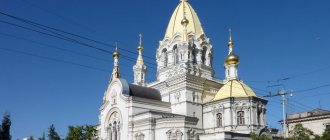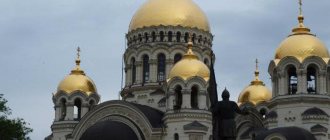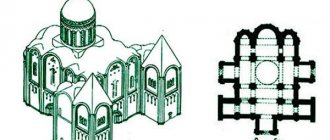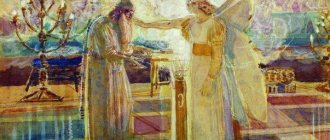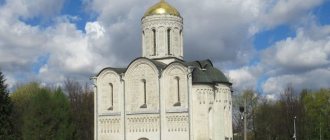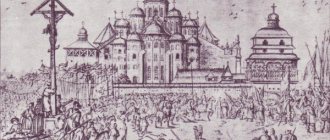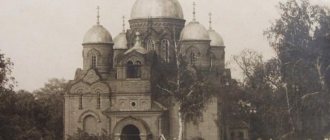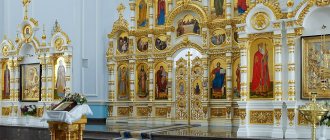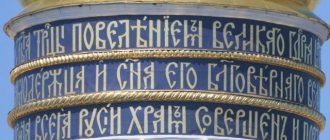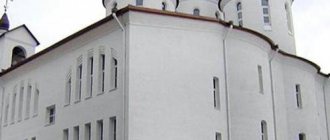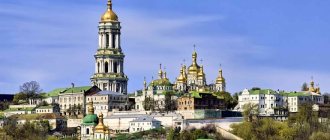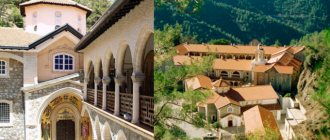In Vladimir, on the steep slope of the Klyazma River, stands the white-stone miracle of ancient Russian architecture - the Assumption Cathedral, which became an architectural monument and a symbol of Ancient Rus', the construction of which was started and completed in the 60s of the 12th century. The temple fascinates and attracts with its grandeur and beauty.
The Grand Duke, Andrei Bogolyubsky, the son of Yuri Dolgoruky, blessed the cornerstone of the future temple on April 8, 1158. The building was erected in just 2 years. Interior work and wall painting with frescoes were completed in 1161. The Klyazma River and its surroundings became the natural backdrop of the majestic building. Beautiful views and beautiful nature set off the whiteness of the walls.
The Cathedral of the Assumption became the main cathedral church of the Suzdal-Vladimir diocese, where the Grand Dukes of Vladimir and Moscow received their blessing to the throne.
How to get to the Assumption Cathedral
Independent tourists can get to the city of Vladimir by car along the M7 highway. Distance - 220 km. Travel time is 2.5 hours. The route from Moscow to Vladimir can be taken by regular buses from the Shchelkovo bus station, Kursk station and Novogireevo bus station. Buses depart every 20 minutes.
You can take the Lastochka train in the direction of Nizhny Novgorod with a stop in Vladimir from Kursky Station. From Yaroslavsky station you can take a transit flight on trains in 9 directions. The Assumption Cathedral is located on the street. Bolshaya Moskovskaya, 56, regular buses can stop at Cathedral Square. The distance from the stations is less than 1 km. Walking distance 14 min.
Useful tips for visitors
Venerate the holy relics in Vladimir, visit a unique monument of white stone architecture of the 12th century. and a huge number of pilgrims and tourists flock to the city to defend the service. Considering that the temple is not only a museum-reserve, but also a functioning church, a number of rules should be observed:
- Do not take animals with you.
- Turn off mobile phones.
- Do not use obscene language.
- Do not smoke on the temple premises.
- Dress appropriately for visiting a holy site.
Entrance to the museum-reserve is paid, photography is prohibited.
Figure 4. Assumption Cathedral on the Klyazma River
How to get to the Assumption Cathedral in Vladimir
The bell tower on the territory of the temple is considered the geographical center of the city of Vladimir, although no one specifically calculated the distance. Address of the Assumption Cathedral: st. Bolshaya Moskovskaya, 56. It is within walking distance from the bus and train stations. You should go down the Communal Descent and turn left. Travel time will be 15-20 minutes.
Visiting mode
The temple is open to visitors six days a week: from 7-00 to 20-00. A non-working day is Monday. Group excursions are held from 13-00 to 16-45 during the break between daytime and evening services. Their schedule depends on the church calendar.
The Assumption Cathedral has gone through a lot during its history. At the same time, he continues to spiritually nourish parishioners through the Word of God. Any visitor here has the opportunity to penetrate not only the history of the Russian land, but also touch the origins of Orthodoxy.
History of construction
The Assumption Cathedral in Vladimir, the construction of which has a rich history, has undergone several stages of development over 860 years, which were reflected in the appearance of the temple, its status, and the way it appears to modern humanity. Historical events of Ancient Rus', enemy attacks, fires left a mark on its walls, paintings, and appearance.
Temple of Andrei Bogolyubsky (1158-1185)
The Grand Duke of Vladimir - Andrei Bogolyubsky in 1157 brought from Vyshgorod to his village Bogolyubovo an icon of the Mother of God, which hung in the air near Vladimir. Shocked by this miracle, the prince saw in a dream the Mother of God, who indicated with a finger and a scroll the place to install the Holy Icon. There they laid the first stone of the future cathedral.
The Assumption Cathedral in Vladimir, the construction of which began in April 1158, was supposed to become the center of Ancient Rus' and unite the scattered principalities around itself. And the icon of the Mother of God became a shrine of the Vladimir diocese. The Grand Duke ordered the frame of the image of the Mother of God to be framed in gold and silver, precious stones and pearls.
The best architects of the time, icon painters, gold and stone craftsmen from Germany and Greece, Galich and Kyiv were invited to build the temple.
The enormous work was completed in just 3 years. In 1161, the interior frescoes and paintings were already ready. The iconostasis was richly decorated with gold and studded with pearls and precious stones. The magnificent decoration surprised and delighted the people of that time. The white shine of the limestone gave lightness to the massive building and added grandeur.
In 1174, Andrei Bogolyubsky died at the hands of the conspirators. The church, left without a patron, was plundered in 1776 by his opponents, the Rostislavichs. They carry out and take away everything valuable from the temple, rich utensils and decorations. The terrible fire of 1185 destroyed not only the Assumption Cathedral in Vladimir, but 32 other churches in the city.
Temple of Vsevolod III (1186-1189)
Vsevolod III the Big Nest, brother of Andrei Bogolyubsky, began restoring the temple immediately a year after the fire. The deplorable state of the burnt-out walls and frescoes, burnt beams, force him to take a different approach to the decision of reconstruction. He calls on local architects for construction.
Having turned the old walls into arched openings-pillars between the naves, they expanded the area of the church and added walls on 3 sides. It turned out that the old church was inside the new building. The increase in the volume of the building led to greater capacity: 5 naves were 30 m long and 30.8 m wide. The altar was also enlarged.
4 helmet-shaped domes were erected at the corners, which were previously assembled around the Great Dome. Three years later, in August 1189, Bishop Luka of Rostov consecrated a new church. In 1193, another fire broke out without causing serious damage. The tombs of members of the princely family and patriarchs were built in the Galleries of the side aisles. The bishop's chambers and other buildings were erected near the cathedral.
The painting of the “Vsevolod galleries” was done in 1237, but the violent events of 1238 in Vladimir destroyed these frescoes. The Tatar-Mongols plundered wealth, stole jewelry, and destroyed icons. The temple was set on fire, and it became the site of the martyrdom of innocent people, Princess Agafya with her children and relatives. Bishop Mitrofan died with them.
Subsequently, all were canonized as the Great Martyrs of Vladimir. In this inferno, the face of the Vladimir Mother of God survived. After the invasion of the horde, repairs took place only in 1280. Metropolitan of Kiev, Maxim settled in Vladimir in 1299, having seen the miracle that the Blessed Virgin Mary gave him. Until 1325, the metropolitanate was located here, until Saint Peter decided to move to Moscow.
Andrei Rublev in the Assumption Cathedral (1408)
After a long time, thorough and extensive work on the restoration of the temple was undertaken by the son of Dmitry Donskoy, Prince Vasily. Talented icon painters, monks Andrei Rublev and Daniil Cherny began updating the interior frescoes of the cathedral in 1408. Their works can still be seen now - time has spared these great creations and carried them through the centuries.
Gospel themes were embodied in the painting of the vaults. The craftsmen made a unique iconostasis. In 1411, the Tatar-Mongols attacked again. This time, in the fire of the conflagration arranged by the enemies, the temple bells perish and melt. In the 17th century, the Cathedral was abandoned; desolation turned its splendor into a habitat for birds.
XVIII century
The steward of Peter I, Nephews Grigory traveled a lot to distant and nearby cities of Russia on sovereign affairs. In 1708, in Vladimir, he was seized by an illness from which he suffered greatly. For the miraculous healing that he received from the icon of the Mother of God of Vladimir, Plemyannikov donated funds for the repair and partial restoration of the semi-abandoned church.
But this renovation changed the temple. The building itself was not strengthened; instead, brick buttresses were added to the corners of the white stone walls. Windows were added to the 2nd tier of walls, and the existing ones were expanded. The helmet-shaped domes were converted into onion-type domes.
Major renovation (1725-1734)
The master roofers who undertook to restore the gable roofing of the old building were unable to complete the job. The hipped iron roof with steep slopes disfigured the “white stone miracle.”
Catherine's renovation 1767-1774
In 1767, Catherine II arrived in Vladimir. The Main Cathedral greeted her with a damaged, dull appearance, without its former festivity and solemnity. The iron roof was corroded by rust and leaked, which spoiled the interior decoration. The paintings began to flow. This circumstance led to the beginning of the restoration of the temple. Ekaterina allocated 14 thousand rubles for repairs.
In 1768, the side galleries were rebuilt into chapels dedicated to Saints Andrew Bogolyubsky and Gleb Vladimirsky. The roof was repaired. The roof was made of sheet iron, and drainpipes were attached to them. The work was carried out by Moscow roofers.
Exterior work removed the ugly brick buttresses at the corners. The cracked windows were restored, and the roof covering was also restored. The bulbous domes were replaced back with helmet-shaped ones. Workers and ministers of the bishopric repaired and whitewashed the walls and vaults. The windows were covered with bars.
The dismantled iconostasis by Andrei Rublev was sold to the peasants of Shuisky district. And the Rublev frescoes were erased and whitewashed on top. According to the fashion of that time, in the Baroque style, they built a three-row rich iconostasis with gilding. The icons for it were painted by local Vladimir icon painters. In May 1774, Vladimir Bishop Jerome held a service for the consecration of the renovated Holy Assumption Cathedral.
19th century
A new century began, kings changed, desolation came to the Assumption Cathedral. The construction of a bell tower in a classical style was supposed to revitalize the area and give new life and breath to the architectural ensemble. In 1810, according to Vershinsky’s design, a bell tower with a spire at a height of 56 m was erected.
In 1862, the new Church of St. George the Victorious, created by Artleben, connected the bell tower with the main building. There was also a new chapel dedicated to the Miracle of the Archangel Michael in Khoneh. In 1871, a baptismal room was added.
Until 1880, no major changes took place other than the erection of an iron lattice fence around the cathedral. A heating system with air heaters was installed. From this year, a large restoration work begins, they are led by Bishop Theognost (Lebedev).
In 1882, archaeological work on ancient paintings was resumed. The head of the restoration commission was I.E. Zabelin. The artistic painting work was carried out by Nikolai Sofonov, a hereditary Palekh master icon painter.
By the beginning of the 90s of the XIX century. Major restoration work restored the ancient gable roof covering. Engineers strengthened the walls and vaults. The facades of the building were faced in places with new limestone. Stone carved reliefs and patterns were partially replaced and the drawings were restored. A western porch (entrance gate) was built. In 1891, on September 29, Bishop Theognost consecrated the renovated temple.
XX century
The revolutionary events of 1917 also affected the Cathedral - it was closed. In order to fight against religion, the Soviet government opened the Museum of Scientific Atheism there.
Since 1944, the cathedral was again open for worship at the request of parishioners. And from that time he has been working to this day. The Assumption Cathedral in Vladimir with its rich history of construction makes it a real monument of North Russian white-stone architecture.
History of the Assumption Cathedral
The main temple from the times of Vladimir-Suzdal Rus', in which the Moscow and Vladimir princes were married, is included in the list of UNESCO World Heritage Sites. This unique monument of the 12th century, which preserves original works by Andrei Rublev, is now a state museum-reserve.
The original temple 1158-1169
The Assumption Cathedral in Vladimir was built under Andrei Bogolyubsky, who dreamed of making it the main temple of Rus'. The church was erected not only by craftsmen from all Russian lands, but also by foreigners. The German builders were sent personally by Frederick Barbarossa. Specialists in bricklaying arrived from Kyiv, masters of white stone technology from the Dnieper region, and gilders from Greece and Galich. The location was chosen in the southern part of the city, on Klyazma.
Construction began in 1158, April 5th. The limestone building, decorated with white stone carvings, rose 5 meters higher than the St. Sophia Church in Kyiv. By 1160 the church building was completely rebuilt, and in 1161 it was painted. A quadruple covered with sheets of gilded copper rushed upward. The height of the central chapter was 32.3 meters. Entrance portals were built on three sides, the facade was decorated with complex pilasters and horizontally divided into two tiers by an arched frieze.
Those who got inside compared the magnificence of the cathedral with Solomon's Temple in Jerusalem. Gold and silver chandeliers reflected in the mosaic tiles that covered the floor. They were made of copper and colored majolica. The vaults and walls of the temple were painted with frescoes, and above the altar there was a platform for reading sermons, made of gold and silver.
Figure 1. Initial view of the Assumption Cathedral in Vladimir
Reconstruction of the cathedral in 1186-1189
In 1185, there was a fire in the city, and the Assumption Cathedral was seriously damaged. The architects restored the building, strengthening it with pylons and surrounding it with a second row of stone walls. The new "case" on the south, north and west sides was attached using arches. In addition to the resulting side galleries, the area of the altar was increased, the cathedral became more spacious (30.8 x 30 m) and had five aisles.
The restoration was carried out for 4 years by Andrei Bogolyubsky’s younger brother, Prince Vsevolod, nicknamed the Big Nest. The year of creation of the cathedral is considered to be 1158, but both brothers are buried in the northern gallery, who are revered as the creators of the shrine.
Further history of the cathedral
The long-suffering temple endured the hardships of the Mongol-Tatar invasion. The events are known when Batu, after the capture of Ryazan, rushed to Vladimir. This happened in 1238. Residents put up heroic resistance to the troops of the Tatar Khan, but were unable to hold the city. The family of Bishop Mitrofan, Princess Agafya Vsevolodovna and numerous defenders took refuge in the Assumption Cathedral. Batu gave the order to set fire to the cathedral, covering it with logs. The people inside suffered martyrdom, suffocating in the smoke.
The temple in Vladimir survived, but the walls and especially the painting were seriously damaged. Holy relics were looted and destroyed. The restoration of churches and the greatness of Rus' began after the victory on the Kulikovo Field. Prince Vasily, the son of Dmitry Donskoy, in 1408 invited two famous masters - Daniil Cherny and Andrei Rublev, who again painted the walls of the cathedral with frescoes.
In the 2nd half of the 18th century. Vladimir was visited by Catherine II, who allocated money for the renovation of the cathedral. 14 thousand rubles were spent on the iconostasis, made in the Baroque style. During the 18th–19th centuries. The appearance of the temple also underwent major changes. A bell tower with a gilded spire was built, which was connected to the cathedral by a chapel in honor of St. George the Victorious.
At the end of the XIX–XX centuries. A scientific restoration was carried out in the cathedral, as a result of which Rublev's frescoes were restored, the domes were gilded, and the white stone was cleaned. The last time the work was carried out was in the 70-80s. XX century.
Architectural features
Bogolyubsky Temple
The first church building (1158-1160) was erected from high quality white limestone. From the outside it looked very elegant and harmonious due to its correct and consistent proportions. Both outside and inside, there was an upward direction in everything, which gave a feeling of lightness and soaring. The vault at its highest point was 32.3 m.
3 naves inside the temple were separated by 6 pillars. 3 apses made up the altar part. The square of the dome with sides of 6.4 m is an elongated quadrangle, but visually it seemed that the building had a cubic shape. The length without apses is 22.5 m, the width is 17.5, the height of the vaults is about 21 m. Thin walls and cross-shaped pillars to match them gave the building elegance and lightness.
The pillars were decorated with pilasters (columns), which were crowned with leaf-shaped capitals. The arches supporting the vault connected to the “drum” of the large dome with tromps - a stepped structure that made it possible to transfer and distribute the load on the arches. This approach was not typical of the architecture of ancient Rus' and was used for the first time.
The dome drum had 12 elongated vertical windows. Each nave of the building had 3 porches (entrances). Large stones and cobblestones served as the foundation, loosely piled underneath. Only the last 2 rows, on which rubble was laid, were strengthened, and walls were erected on them.
The walls are decorated with an arcature belt consisting of columns, some of which are preserved on the northern wall of the temple. A decorative belt of columns crowns the curb. The upper base of the columns (capital) is cube-shaped, the columns are based on wedge-shaped consoles. The space between the columns is painted on the plastered surface.
The facades were decorated with pilasters with capitals in the Corinthian style, that is, bell-shaped.
The horizontal division of the facade with a decorative arched frieze was an additional decoration of the solid walls. There is a version that the walls of the original cathedral are from 1158-1160. were decorated with relief figures that have not survived. Decorative sculptures were of a zooanthropomorphic type - an ornamental carved belt with figures of fantastic creatures and animals.
The zakomaras (the semicircle of the junction of the roof and the wall) along the central façade were decorated with reliefs based on the biblical story about Babylonian youths, Christian warriors and Alexander the Great with griffins. Masks of lions and women decorated the window openings.
The picturesque painting, surviving in fragments, is located between the pilasters of the arcature-decorative belt on the northern side of the gallery - figures of prophets and peacocks. It is possible that they were the exterior paintings of the cathedral.
Temple of Vsevolod
The construction of the “Vsevolodov Galleries” around the old building of Prince Andrey began quickly. The new Cathedral turned out to be more majestic and larger. The facades of Vsevolod's galleries are decorated with vertical pilasters, the upper part of which ends with zakomaras.
The low arrangement of the galleries (the completion of the walls with a semicircle or wedge) created steps and attractiveness for the new building. The apses were lengthened. A decorative belt of arches with 114 columns divides the facades into two horizontal parts. Narrow, slit-like windows are located on the lower level, and wide ones with bevels are located on the upper tier.
The walls of the galleries are made of white limestone, but are inferior in quality to the white stone limestone of the Bogolyubovsky temple of 1158-1161. Some external walls were decorated with relief decoration. Some of them were moved from the walls of the old cathedral.
The Assumption Cathedral in Vladimir, the construction of which was entrusted by Vsevolod III to local builders, had a tendency towards the Byzantine style of architecture. The Bogolyubov Church was built by architects sent by Frederick Barbarossa, who partly applied the Venetian style of construction.
Interior decoration
According to legends and chronicles, Andrei Bogolyubsky did not skimp on the interior decoration of the temple, where the relic and shrine of Ancient Rus', the icon of the Vladimir Mother of God, was supposed to be kept. Sculptural compositions and decorative reliefs were carved and covered with gilding, frescoes decorated the walls and vaults. Church utensils were entirely made of gold and silver, decorated with precious stones.
Three massive, carved doors are covered with gilding. The Cathedral of the Assumption was compared to the Temple of Solomon in terms of the luxury of its decoration and interior. Painted frescoes of the 12th century have been preserved in separate elements - these are the figures of Artemia and Avramia on the southwestern wall, as well as on the paintings on the pillars behind the iconostasis.
Archaeological research 1882-1884 touched on the interior decoration and revealed the magnificent works of Andrei Rublev.
The works of ancient icon painters of the Moscow school have been preserved in fragments and in complete form, occupying more than 300 sq.m. area of the walls and vaults of the Assumption Cathedral. These paintings are proof of true high art and talent, a vivid manifestation of ancient Russian painting. Spirituality, humility and kindness shine through in the views of the characters in the images. They express the special spiritual mood of that time.
Rublev and Cherny used all the architectural features of the cathedral vaults, and skillfully wove human figures and image shapes under the lines and breaks of the structure. All compositions of the temple are subordinated to one theme - the spiritual uplift of the Russian people. The iconostasis made by Rublev consisted of 4 rows, where 83 icons were placed. At one time, it was the largest iconostasis.
Both the frescoes and the iconostasis were created in the same style, and mutually complemented each other, forming a single composition, combining the sculptural and architectural parts of the cathedral with artistic techniques. The paintings attracted the eye with their sophistication.
Throughout the work of Andrei Rublev, a single style can be traced: elegance and grace of figures, sincerity and mercy, peace and love in the eyes, faces of angels, apostles, wives and children. In 1774, on the site of the Rublevsky iconostasis, the merchants Bochkarevs built another one, in three tiers, in the Baroque style, which became fashionable in those days.
The carvers completed a difficult job and built a 20-meter structure, with wide cornices between the tiers. With carved columns and pilasters with Corinthian capitals. Icons were placed in carved frames with intricate patterns. The gilding of the iconostasis was done with red gold on a green-emerald background, and made a huge impression on the parishioners.
In the center of the iconostasis is a high relief of Hosts. The sides of the iconostasis are crowned with sculptures of eight angels.
The carved Royal Doors depict the Annunciation. The figures of the Archangel and the Virgin Mary represent the gates. The entire composition consists of ornate patterns of leaves, flower garlands and fruits, which gives the gate great whimsicality. 123 icons were painted by masters of the Vladimir bishop's house, in oil on linden boards.
At the turn of the 70-80s of the twentieth century, detailed and complex restoration work was carried out to preserve the treasury of the architectural miracle of Ancient Rus'. The white stone limestone was cleaned and treated with a special compound. The five-domed domes were gilded. The paintings inside the church were strengthened with special solutions, and the temperature and humidity inside were regulated for preservation.
Relics
The main relic and shrine of the Assumption Cathedral is the icon of the Vladimir Mother of God. According to traditions and legends, it is known that it could have belonged to the brush of the Evangelist Luke, who saw the Virgin Mary during her lifetime. And the boards on which the Mother of God and Child were depicted were taken from the table at which the holy family of the Savior ate. It was such an icon that could work miracles.
Chronicles say that it was kept in Jerusalem until the 5th century, then transferred to Constantinople. The icon was presented by the Patriarch of Constantinople Luke Chrysoverg to Prince Mstislav in 1131. It was stored in Vyshgorod near Kyiv. Grand Duke Andrei took her to Bogolyubovo. For the signs and wonders performed, the Icon was made a Shrine and Relic of the Assumption Cathedral in Vladimir.
Its beneficial influence was always noticeable at important stages in the formation of the Russian state. She protected Rus' with her grace, protecting it from invaders, as evidenced by numerous manifestations of miracles. The Vladimir Mother of God is a strong, miraculous icon, “prayed”, which truly is the intercessor of those who turn to her with a pure heart.
Its protection extends to all areas of human life. It gives strength, faith and hope. As the true Mother of God, she protects people from sin and evil, from quarrels, protects marriages and families, and delivers from illnesses. Art historical studies say that the icon was painted in the 12th century, and is a copy of the image of the Mother of God, which was painted by the Apostle Luke in the time after the death of Jesus.
Since the 12th century, the icon has been updated 4 times, and only fragments of the original images have survived to this day. Our Lady of Vladimir was transported to Moscow in 1480. The cathedral loses its diocesan significance until the 18th century. The Vladimir Museum contains the Rublev image, a copy of the Vladimir Icon, which was located in the Cathedral of the Assumption until 1944.
The Assumption Cathedral in Vladimir, the construction of which was dedicated to the shrine, the icon of the Vladimir Mother of God, stores two more precious relics.
The Bogolyubskaya Icon of the Mother of God is a shrine of Bogolyubovo, later moved to the Assumption Cathedral. It was written in 1157 after the appearance of the Mother of God to Prince Andrei Bogolyubsky. It was in this position, with one hand raised and a list in the other hand, that the Mother of God appeared and indicated the location of the storage of the icon of the Mother of God from Constantinople.
An equally revered shrine is the Icon of the Maximov Mother of God, created in 1299. Patriarch Maxim, who came from Kiev, was visited in a vision by the Mother of God and presented him with an omophorion. The saint woke up with real vestments in his hands.
The saint accepted this miracle as a blessing from the Mother of God - he transferred the metropolis from Kyiv to Vladimir. The omophorion of the Mother of God was kept in the Assumption Cathedral for 112 years. In 1141, after an attack by the Tatar-Mongols, it was lost.
What to see
To paint the interior in 1408, eminent Moscow icon painters were invited - Andrei Rublev and Daniil Cherny, whose frescoes have partially survived to this day.
Fragments of images on the theme of “The Last Judgment” can be seen in the western, northern and altar parts of the church. But most of the paintings decorating the cathedral are replicas from the 19th century.
In the 17th century, at the direction of Empress Catherine II and with her donations, the temple was renovated. Then the medieval iconostasis was replaced with a new, baroque one, and at the beginning of the 20th century, the icons on it by Rublev were sent to the State Russian Museum and the Tretyakov Gallery.
Great princes and clergy are buried in the necropolis, some of them are holy great martyrs. Here lie the founder of the Assumption Cathedral, Prince Andrei Bogolyubsky, Vsevolod the Big Nest, his son and daughter, martyrs Mitrofan and Patricky. Pilgrims come to venerate the relics of St. Alexander Nevsky, the commander whose troops defeated the Teutonic knights on Lake Peipus, as well as the remains of St. Simon, Maxim, and Serapion. Here you can also venerate the icons of the Bogolyubskaya, Vladimir, and Maximovskaya Mothers of God (these are copies of famous originals).
Necropolis
The large cathedral in all cities and countries is the burial place of famous people, saints, saints and martyrs. More than 40 members of the princely family, canonized as saints and revered by the church and people, found their final refuge in the Assumption Cathedral.
In the galleries of the cathedral, from 1193, family members of the princely family began to be buried in arcosolium niches. A place of honor at the altar, in the northern gallery, was allocated for the repose of the founders and builders - Andrei Bogolyubsky and Vsevolod III. The bishops of the Vladimir diocese rest in the necropolis.
The ancient necropolis preserves the ashes of the blessed Grand Duchess Agafia Vsevolodovna, who died during the siege of the Tatar-Mongol troops in 1238. Hieromartyr Mitrofan, who died with Princess Agafia, rests here. In 1645, the relics of Grand Duke George Vsevolodovich were discovered incorrupt.
Interesting Facts
Historical facts say that the temple had a very difficult fate and long development. Several fires, Tatar-Mongol raids, robberies could not destroy the true art of ancient Russian architecture.
Spiritual foundations, the reverent attitude of generations towards the cathedral as a religious relic, the deep and true faith of people helped it become more beautiful and better:
- in 1410, the temple was again attacked by the Tatar-Mongols, who plundered and set fire to it. The bells burned out. The housekeeper Patrick hid part of the precious church utensils, for which he was tortured by his enemies. Whether he gave away his hiding place or not, nothing is said about this in the chronicles. It may happen that the lost jewelry will be found and take its place in the cathedral, as a memory of the centuries-old history and feat of Patricius;
- frescoes with prophets and peacocks, found inside the Vsevolod Gallery on the north side, say that the temple of Andrei Bogolyubsky had painted outer walls. It is easy to imagine the splendor and flowering along the walls of the snow-white building;
- restoration 1888-1891 recreated the appearance of the Cathedral of Vsevolod III, which has survived in this form to the present day;
- The Assumption Cathedrals in Moscow and Vladimir are similar, but they are distinguished by many architectural details;
- “zero kilometer” in Vladimir is counted from the bell tower of the Assumption Cathedral;
- Russian emperors and tsars always visited the cathedral before ascending the royal throne.
Assumption Cathedral in Vladimir today
Worldwide interest in the Assumption Cathedral appeared at the end of the 19th century, as a unique monument of Russian white-stone architecture. Its careful preservation for more than 8 centuries speaks of the historical and cultural significance of the cathedral in the life of Ancient Rus' and Russia.
The Vladimir diocese, on behalf of the Russian Orthodox Church, and the Vladimir-Suzdal Museum conduct joint activities within the walls of this cathedral-monument. Regular services and museum exhibitions have been held together since 1944.
Much attention is paid to the technical condition of the building; research and control are carried out on temperature conditions and air humidity in the premises to preserve the rarest ancient paintings and icons. The general condition of the cathedral meets all the requirements for such historical buildings.
Except for the baptismal room, where the service premises are located, all buildings are used according to the original plan. The official name of the temple is “Holy Assumption Cathedral”. It is open to the public every day from 7-00 to 19-00, except Mondays from 7-00 to 12-00. During services, admission to the cathedral is free. Services are held every day from 7-30.
On Sundays and holidays there are morning liturgies from 6-30 and 9-00. The evening service begins at 5:00 p.m. The Vladimir-Suzdal Museum is open with one day off on Monday, on other days from 13 to 16-45.
The Assumption Cathedral in Vladimir is open on all days except Monday. Everyone can visit the cultural building.
| Museum ticket prices | Adult | Children from 7 to 16 years old | Children over 16 years old, students, pensioners |
| Entrance ticket without excursion service | 150 rub. | For free | 75 rub. |
| Entrance ticket with professional guide | 300 rub. | 100 rub. | 150 rub. |
Photography is prohibited in the temple complex.
Every day, the Assumption Cathedral in Vladimir is visited by hundreds of people who want to touch the centuries-old history of the monument, the construction of which glorified the name of its creator for centuries, and made the temple a symbol of the glorious city.
Author: Liliya Ivanova
Article design: Oleg Lozinsky
Interesting facts about the Assumption Cathedral
The Orthodox Church has always been active, with the exception of the post-revolutionary period. From 1917 to 1944, no services were held, but parishioners and priests managed to distinguish themselves during the Great Patriotic War and receive awards from I. Stalin. They managed to collect a huge amount of valuables, which was enough for an entire tank column.
Interesting facts are also connected with the icon of the Vladimir Mother of God, in whose reign Dmitry Donskoy and Alexander Nevsky, two outstanding Russian commanders, were married. According to legend, the shrine was lifted into the air and flown with it on an airplane around Moscow on the eve of the decisive battles for the capital. And this was done on the orders of Stalin.
